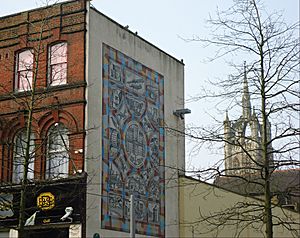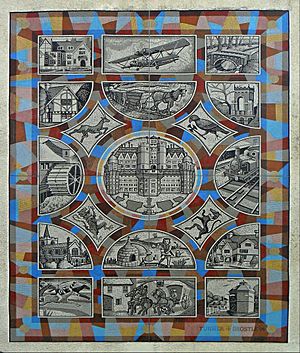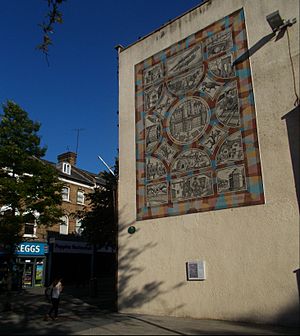Sutton Heritage Mosaic facts for kids
Quick facts for kids Sutton Heritage Mosaic |
|
|---|---|
 |
|
| Artist | Rob Turner and Gary Drostle |
| Year | 1994 |
| Medium | Mosaic made with ceramic tile |
| Location | Sutton, London, UK |
The Sutton Heritage Mosaic is a huge piece of art made from many small, colorful pieces. It's like a giant picture on a wall! You can find it in Sutton High Street in Sutton, England. This amazing mosaic is one of the biggest wall artworks in Britain. It was created to celebrate the history of the area, known as the London Borough of Sutton.
Contents
Where to Find the Sutton Mosaic
You can see this large mosaic on the side of a three-story building. It's right on the corner of High Street and St Nicholas Road. This spot is part of Trinity Square, which is the main town square in Sutton.
What the Sutton Mosaic Shows
The mosaic is really big! It's about 9 metres (30 ft) tall and 5 metres (16 ft) wide. It tells the story of Sutton's past through nineteen black and white pictures, called panels.
The most important part of the mosaic shows Nonsuch Palace. This was a grand palace built by King Henry VIII in Nonsuch Park. Around the palace, you can see special animals from the coats of arms of old local families. These families include the Carews, Gaynesfords, and Lumleys.
The mosaic also features important buildings from Sutton's history. You can spot Honeywood House and All Saints Church in Carshalton Village. There's also the Old Cottage and Whitehall in Cheam Village.
The artwork also shows old jobs and industries from the area. For example, it includes a mill from the River Wandle. Mills used the river's power to grind grain or do other work. You can also see an early railway line, which ran next to the river. And look closely for a Hannibal biplane! This type of old airplane used to fly from the former Croydon Airport.
How the Sutton Mosaic Was Made
The idea for the mosaic came from an artist named Rob Turner. He worked with another artist, Gary Drostle, to create it. They showed six different designs to the local Public Arts Committee. The committee chose the design that showed Sutton's history in nineteen panels. A company called Appledown Properties Ltd helped pay for the project.
The mosaic was put together in 1994. It was made using tiny pieces of shiny ceramic called tesserae. The artists didn't build it directly on the wall. Instead, they used a special "reverse technique" in a studio.
First, they drew a full-size outline of the mosaic on paper, but backwards! Then, they glued the small tiles onto the paper using a simple flour-and-water glue. Once all the pieces were in place, they put the mosaic onto the wall. Finally, they washed off the paper and glue with water. After that, they filled the gaps between the tiles with grout and polished the whole thing.
This amazing mosaic has more than 100,000 tiny pieces! It took the artists over 1,500 hours to design and build it. That's a lot of hard work!
Learning More About the Mosaic
In 2011, a special plaque was added near the mosaic. This plaque helps people understand what each of the nineteen panels means. Councillor Graham Tope helped unveil the plaque. He said that the mosaic has been a "much-loved feature" for many years. He hoped the plaque would help people learn more and appreciate the artwork even more.




